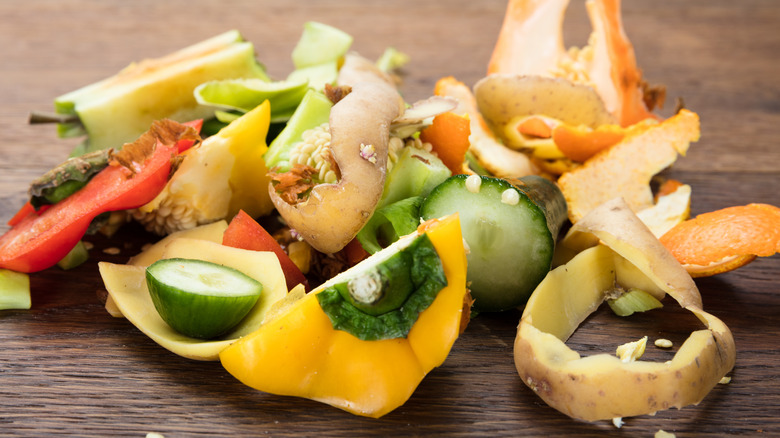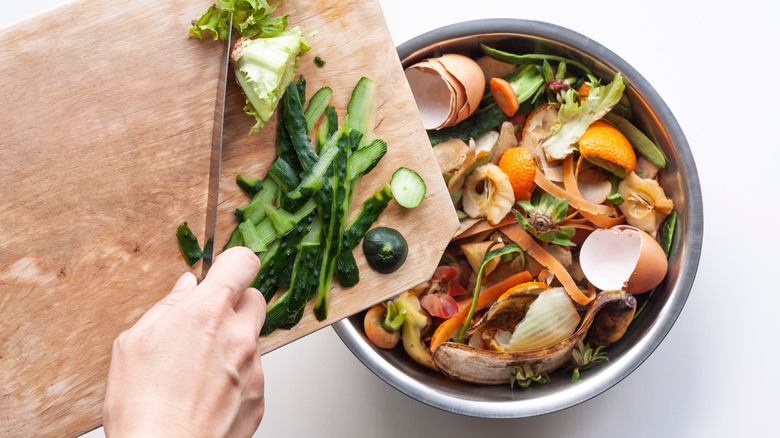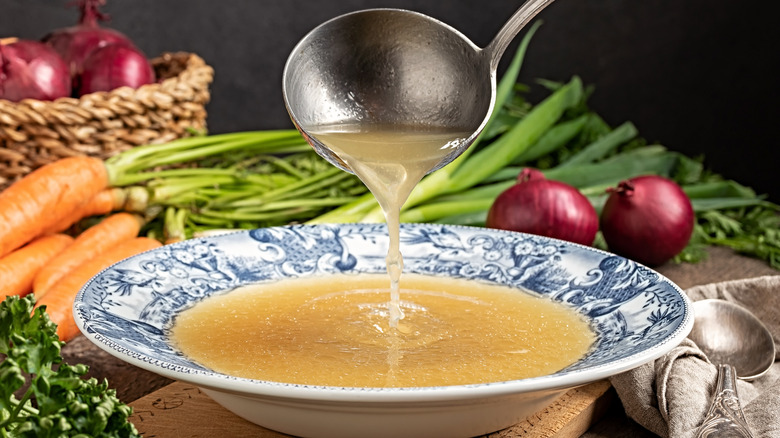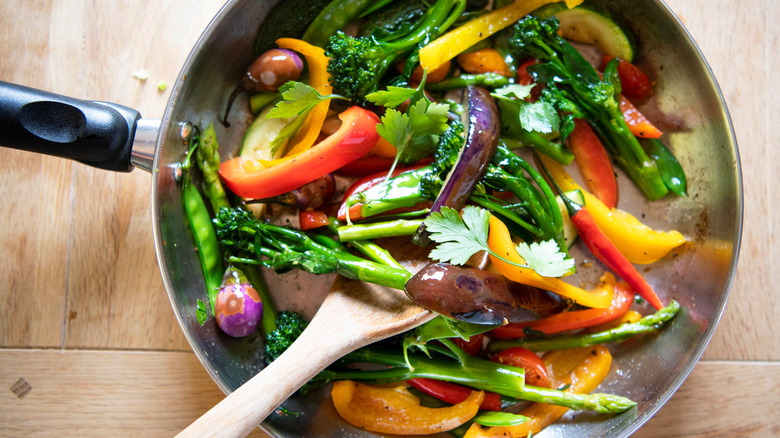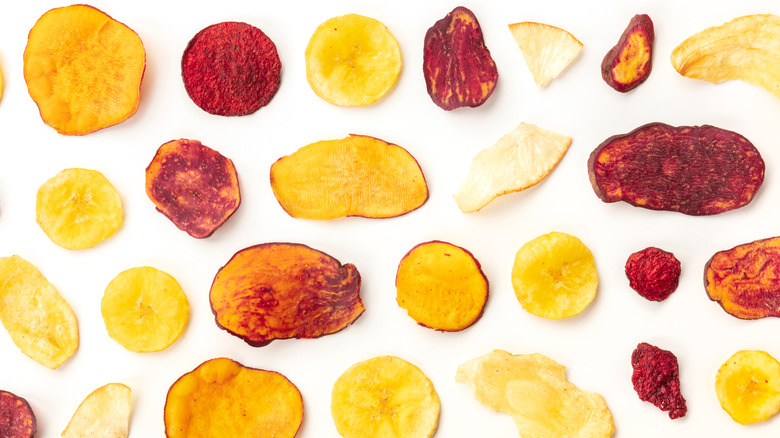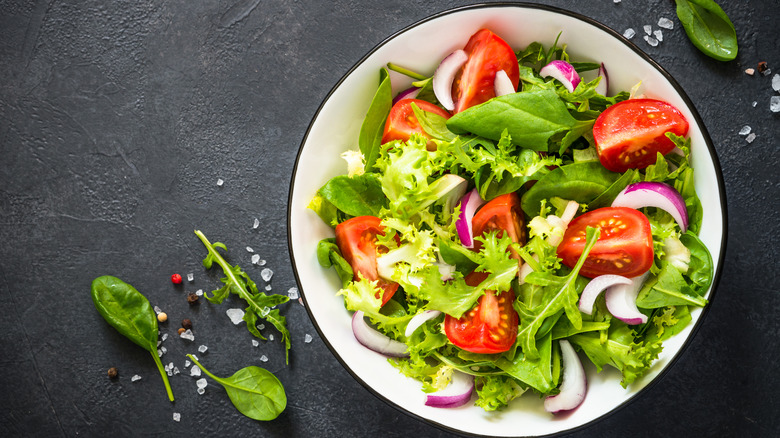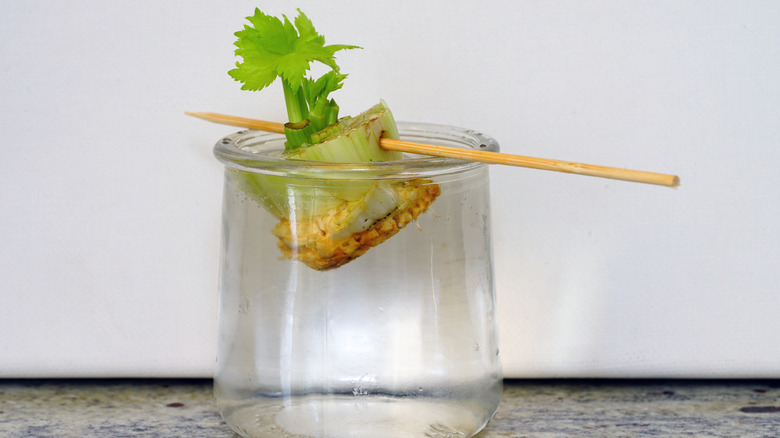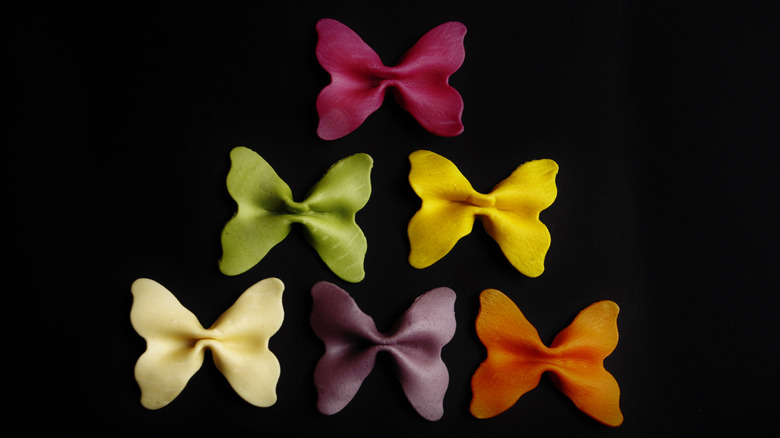7 Ways To Use Up Your Vegetable Scraps
Many people tend to cut off parts of vegetables before they use them in a lot of dishes. Everything from the ends of squash or the peels from carrots to the leaves on vegetables can end up as food waste. And according to Zero Waste Memoirs, as much as 40% of food grown and sold in the United States ends up not being consumed. That's why putting every scrap of your leftover vegetables to good use is well worth the effort.
While some methods might be more obvious, such as composting leftover vegetable scraps, other means for recycling or repurposing the veggies to good use are far more creative. Whether you want to make an all-natural food dye or to find a new and delicious way to eat vegetable scraps, there's a way to do it. With a little more effort and some culinary creativity, you will undoubtedly be surprised by all that vegetable scraps can do.
Compost them
Composting kitchen scraps is nothing new for environmentally conscious kitchens, but it might be for some home cooks. Composting vegetables is simply the act of allowing organic materials, such as vegetable leftovers, to decay, as Taste of Home explains. While this might not sound like a particularly exciting or fun use for the scraps, it actually produces an incredibly useful material for those who garden or even have a pot of herbs. With time and after the combined organic items have broken down, those previously discarded vegetable scraps, fruit peels, paper, leaves, nutshells, and more will turn into soil that has tons of nutrients for new plants to feed on and grow.
According to The Kitchn, there are several ways to get started. The easiest methods are to compost on your kitchen counter or in your freezer. All you have to do is place scraps in a container. You might want to use an airtight container if it is going in your freezer, though. To actually put your compost to use for your plants, add leftover scraps to the blender and whirl them into a watery paste and go ahead and add them to the soil of your plants with something like stale bread.
Boil them into a broth
It's always a good idea to have broth on hand to make all kinds of dishes. From soups and stews to risotto and casseroles, there are so many ways you can use broth. That's why using leftover vegetable scraps to make broth is such a good use for what could otherwise become food waste. Better yet, making homemade vegetable broth using your leftover scraps is very easy to do, as Tasty notes, and it's also customizable so you can control how much sodium among other things are in the broth.
According to Serious Eats, you can simply place the scraps (frozen or not) in a pot and cover them with water. You can also add other ingredients like aromatics, such as garlic or a bay leaf, to add more flavor. Cook the broth for 10 minutes only. Strain the broth through a sieve and store it in the fridge or freezer depending on how soon you plan to use it. As the publication explains, a vegetable broth made from scraps will not thicken on its own, and it is best compared to store-bought stock.
Cook with them
If you prefer to put your leftover veggie scraps to hard work in the kitchen by using them in your cooking, then consider a sauté. Healthline suggests sautéing the stalks of greens such as kale to make a healthy side dish. This could also be done with other kinds of stalks such as those of Swiss chard, fresh broccoli, or even cauliflower.
Though you could eat the stalks on their own after sautéing them, they could also be used in other dishes such as quiche once cooked. When being used in another dish where the vegetables won't be as easily seen, you could also add in other kinds of vegetable scraps such as carrots or even the ends of zucchini if it is finely chopped.
To sauté leftover vegetables, simply add them to a hot non-stick pan or a skillet with some kind of fat such as olive oil or butter. Toss the vegetables so they cook on both sides and remove from heat to enjoy or use as you'd like.
Turn them into veggie chips
Cooking vegetable chips is another easy way to use up vegetable scraps or leftovers you might have. From the stemless ends of carrots and potato peels to the leafy greens from broccoli and so much more, you can easily bake, broil, or fry the scraps into crisp veggie chips, according to Zero Waste Memoirs. Not only will this solution reduce your food waste, it will also provide a healthy snack that satisfies your need for crunch.
To make homemade veggie chips, you can always turn to a deep-walled pot and fry them on the stovetop. An air fryer should also work. But to bake your vegetable scraps into a delicious snack, simply slice them thin chips, toss them in (a touch of) oil and seasonings, and spread the chips out on a baking tray in a single layer (via The Big Man's World). Once prepped, just bake the chips for 10 minutes on each side in a 400-degree Fahrenheit oven.
Add them to a salad or wrap
For vegetables that have leafy green tops, such as carrots, radishes, and celery, among others, you don't have to discard the leaves. Instead, they can be used right alongside other greens such as spinach, arugula, and endive. While you can use the leaves in cooked dishes that call for steamed or sautéed greens, the easiest method is to toss them into salads or other dishes with raw veggies, according to Healthline.
The best part about using vegetable greens in salads, wraps, or sandwiches is that they require very little effort to use. You just need to place them in whatever it is you are preparing. Of course, if you are preparing other things like pesto, smoothies, hummus, or a green juice, you can also add the scraps into those spreads and drinks as well. It's all about finding a creative place to put leftover greens just as you would greens that had been purchased.
Grow them into new vegetables
If you have enough of a vegetable's leftover, you can actually start new plants, according to GardenTech. Even the large seed in some produce like avocados can be used to sprout roots and regrow the produce. This is a project that will take time and effort, though. But if you don't want to put your vegetable scraps to another use or you simply can't for whatever reason, this is a good alternative to try to revive what's left. And if it works, it's very rewarding.
To grow new vegetables from leftovers, you'll need to first trim the end of the vegetable. This allows the vegetable to take up fresh water and start to regenerate roots as well as new growth. Once the vegetable has been trimmed, simply place it in fresh water and set it somewhere with a good source of natural light. With time, the vegetable should grow, but be sure to refresh its water regularly when it starts to get cloudy.
Use them as a natural dye
Finally, a fun and creative way to use up all kinds of vegetable scraps is to make natural dye with them (per Zero Waste Memoirs). But instead of using the dye for fabric — though you could — the all-natural dye is perfect for coloring other foods for a festive or cheery meal. Everything from hard-boiled eggs (at Easter) to fresh pasta can be transformed by using colorful homemade dye.
According to Alpha Foodie, you can use beets and peppers to make red and orange dye, depending on their color. Yellow can be made using yellow bell peppers or even turmeric. Use spinach for green and red cabbage for purple dye, too. It's only a matter of processing the vegetables with the flour and egg needed to make a vibrant pasta dough once you know the color you want to make. A blender or a food processor will do, but if you make more than one color, be sure to wash the appliance well in between dyes to ensure the best colors.
